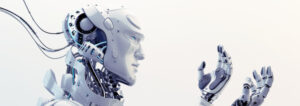What does the future of work look like?
- 4 Min Read
We have a responsibility, as HR professionals, to recognise and respond to workplace trends to strike a beneficial balance to both employees and businesses, but what are these trends – and how can we manage them in the future?
- Author: Andy Rogers
- Date published: Feb 19, 2018
- Categories

Recent years have seen a number of changes to regulations that impact the workplace, but we are also witnessing a number of other factors that are transforming the way people work and the way they think about work. We need to stay ahead of these trends.

As employers, we must recognise the need for learning to take place at all levels and recognise any barriers holding people back, which can be rooted in; culture, life experiences, values, vocabulary, thinking styles and organisational practices.
Intergenerational learning
The term ‘intergenerational learning’ is where older workers learn from young and vice versa – is transforming traditional models of training. It is imperative that as HR professionals, we drive employee engagement and lead from the front, as the emergence of millennials in the workplace adds a new dimension and new skillsets to the workplace. This continues to be an ever-changing phenomenon and with five generations now in the workplace, it would be naïve for employers not to adapt training schemes and share expertise amongst young and old alike.
Personal branding
Personal branding is taking on a new life and getting deeper scrutiny, as employers look to understand potential risks and leverage the power of employees’ personal brands for the good of the company. Personal and corporate brands have always been considered entirely separate, but the lines are now blurring as the value of influencers in the workforce is becoming increasingly relevant and appreciated. But this could impact the way employers engage with employees as one could become more important to the other.
Embracing technology
A company’s success can be transformed by better employee engagement, and despite the prediction that more than two million jobs will be filled by robots in the next eight years, some uncertainty still exists about their limitations and the impact this technology will have on workplaces and their culture. It will certainly be interesting to see how leaders adapt to directing their businesses over the next 25 years, in terms of the relationship between human and robot.
Some companies are embracing their new ‘colleagues’ and recognising the potential for increased productivity, whilst others are more sceptical and anxious of being replaced. But we have already seen examples of humans working alongside their new co-bot colleagues to generate better results, which one could not have achieved without the other. So, our main challenge is to ease any fears of robots ‘taking human jobs’ whilst helping employees understand the possibilities they can offer.
Work/life balance
As the lines between work and ‘life’ become even more blurred, workers will seek more than financial or functional benefits from their employers. Increasingly, we expect our workplace not to be a source of stress but a wellness destination, where employees can experience an environment that maintains or even enhances their quality of life and physical and mental wellbeing. This goes beyond the insurance type packages that many large businesses already offer.
Lastly, the newest iteration of collaborative workspaces takes co-working to a new level. Organisations are not only sharing physical space and resources, but intentionally structuring interactions across job functions and specialisms that encourage problem-solving approaches, in order to combine strengths and address global issues.
It is clear that the make-up of workplaces is going through a challenging, but exciting period of disruption. As business leaders and HR practitioners, it is crucial to recognise the underlying trends driving workplace changes, so we can influence change in our organisations and stay ahead of – rather than follow – the trends.
Download the 2017 Sodexo Global Workplace Trends Report here
Author
Andy Rogers is the HR director at Sodexo UK & Ireland.




